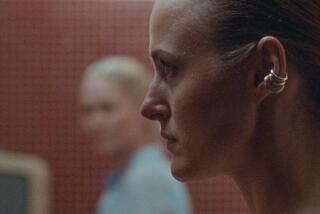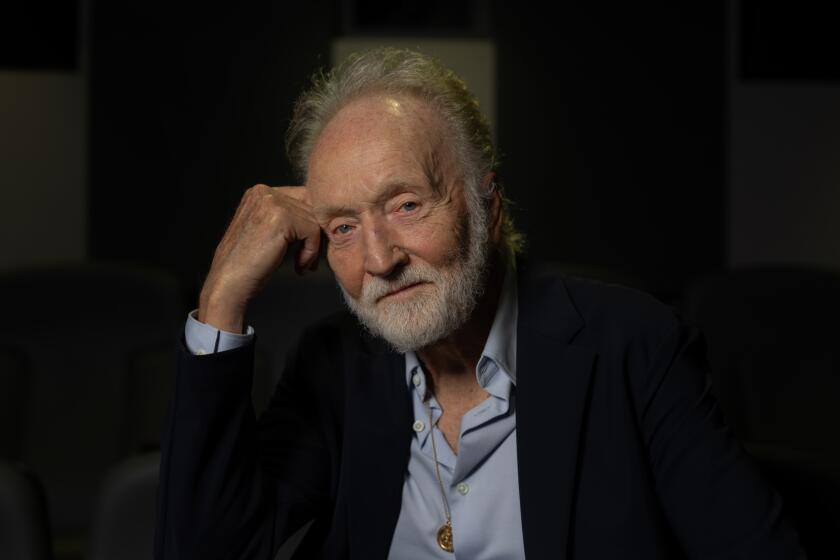All eyes on the queen
Sofia Coppola’s “Marie Antoinette” opens with a shot of the last queen of France reclining on a chaise while a maid tends to her feet, surrounded by a parapet of pastries. On the soundtrack, the 1980s post-punk band Gang of Four belts out its class-baiting, anti-consumerist anthem, “Natural’s Not in It.” (“The problem of leisure / what to do for pleasure,” it goes.) A confection herself, Marie Antoinette (Kirsten Dunst) selects a pastel-colored macaroon from a tray and takes a nibble. The whole time she’s gazing saucily at the camera as if to ask if we’d like to make something of it. Maybe we would.
It’s funny, when it’s put to you this way, how much of the lore surrounding Marie Antoinette is dessert-related. Combine the cream-puff fashion and design sense, the infamous (and apocryphal) cake quip and the sweet retaliatory indulgence of her demise, and you get a clever, visually gorgeous theme that’s both emblematic of an unfathomable life and somehow weirdly familiar.
“Marie Antoinette” gives a wide berth to the conventions of period dramas, especially their time-capsule remove, and instead tries to mainline the singular personal experience of the arch-villainess of French history (and freedom history, for that matter). The result is a startlingly original and beautiful pop reverie that comes very close to being transcendent.
Since the movie’s premiere at Cannes, where legend has it was met with a chorus of boos (who was in the audience, Robespierre?), the reaction to the movie has been polarized. This sort of thing seems to happen a lot to big-budget, star-studded movies that look like Hollywood but feel like art-punk. The movie was inspired by Antonia Fraser’s biography “Marie Antoinette: The Journey,” a compassionate and thorough account (or so I understand) of the monarch’s life. But Coppola is less interested in setting the historical record straight than in making an emotional connection to a misunderstood young girl whose coming-of-age took place under conditions familiar to a pampered zoo animal.
The youngest daughter of Holy Roman Emperor Francis I and Maria Theresa, archduchess of Austria, a 14-year-old Marie Antoinette was shipped off to Versailles to marry the dauphin of France, thereby securing a fragile Franco-Austrian peace. Her mother (played by an imposing Marianne Faithfull) warns that the French court is not like the Austrian, and she’s not kidding.
From the moment the soon-to-be dauphine steps onto French soil, she finds herself trapped in a funhouse of bizarre protocol. From the ritual handing-off ceremony where her new chaperone, the Comtesse de Noailles (Judy Davis), rids her of every last scrap of her Austrian past -- including her clothes and her puppy -- almost to the day she and her husband, Louis XVI, get packed off to Paris by an angry mob, Marie Antoinette’s life was at once cloistered and open to the public. The massive spectacle of her quickie wedding to the future king (played by Jason Schwartzman) is rivaled only by her well-attended wedding night, which is kicked off by a bed-consecration ceremony to which le tout Versailles apparently has ringside seats. This, unfortunately for Marie, is about as freaky as it gets. The marriage remains unconsummated for seven years -- a fact of which everyone, her mother included, is mortifyingly well apprised.
So begins a lonely, lost Marie Antoinette’s transformation from dutiful, pliable daughter to party girl and eventual tabloid whipping post. (Pamphlets printed on illegal presses in Paris routinely portrayed her as a nation-bankrupting hussy.) Trapped and powerless, she soldiers through the marriage and succumbs to the bizarre rituals and internecine rivalries of the court until the sudden death of the lusty and dynamic Louis XV (Rip Torn) grants the teenage couple the run of the country, at which point the queen begins to close ranks.
What with the best-friend entourage (Mary Nighy as the Princesse Lamballe and Rose Byrne as the Duchesse de Polignac), the vindictive rival (Asia Argento as the infamous Du Barry), the gossipy hangers-on (Molly Shannon and Shirley Henderson as Aunt Victoire and Aunt Sophie), the limitless credit, shopping addiction, round-the-clock partying, reckless gambling and public dissection of her love life, Marie Antoinette was the original teenage celebutante princess. And who better to empathize -- and feel at home in the milieu -- than Coppola? A style icon and member of Hollywood royalty herself, she slips easily into Marie Antoinette’s beautiful, unbelievably whimsical shoes (which were designed for the movie by Manolo Blahnik), hooking into the soundtrack of her teenage years to impart the experience. Incidentally, and really quite beautifully, that particular period in pop corresponds with the transition from post-punk to New Wave to New Romanticism; that is to say, from yawping social criticism to desolation to ironic baroque decadence.
Coppola has a soft spot for characters who live their lives at once cut off from and exposed to the world. And she captures the gilded-cage experience, in all its romantic decadence, like nobody else. The movie is at its strongest when it focuses on Marie Antoinette’s private, sensual world, which -- as she drifts into her much-mocked Rousseau-inspired pastoral phase, in which she attempts, in her inimitably artificial way, to connect with her natural self -- becomes ever more abstract and cut off from reality. Dunst’s sleepy, detached quality is perfectly suited to the character. What Marie Antoinette wants is to lose herself in a dream.
Coppola empathizes with the queen’s private suffering as well as with her detachment but recognizes this detachment as dangerous. At the beginning of the movie, Marie Antoinette is 14. At the end she’s 34. The country is deeply in debt, bankrupted by excess and a foreign war (the American Revolution) it can’t afford. Meanwhile, the queen has been trying to find herself through shopping.
This feels not so much like a warning as a melancholy and resigned realization -- which is interesting for a movie that aligns itself so closely with punk rebellion. Toward the end, I found myself waiting for clues to the coming eruption of reality. But when it finally comes, it feels cursory. Hermetically sealed inside Marie Antoinette’s world, you don’t see it coming, and you don’t know what to make of it when it arrives. The hungry mob shows up waving pitchforks, and you half wonder if perhaps they might like a piece of cake.
*
‘Marie Antoinette’
MPAA rating: PG for sexual content, partial nudity and innuendo
A Columbia Pictures release. Writer-director Sofia Coppola. Producers Ross Katz, Coppola. Based on the book “Marie Antoinette: The Journey” by Antonia Fraser. Director of photography Lance Acord. Production designer KK Barrett. Editor Sarah Flack. Costume designer Milena Canonero. Music producer Brian Reitzell. Running time: 2 hours.
In general release.
More to Read
Only good movies
Get the Indie Focus newsletter, Mark Olsen's weekly guide to the world of cinema.
You may occasionally receive promotional content from the Los Angeles Times.










